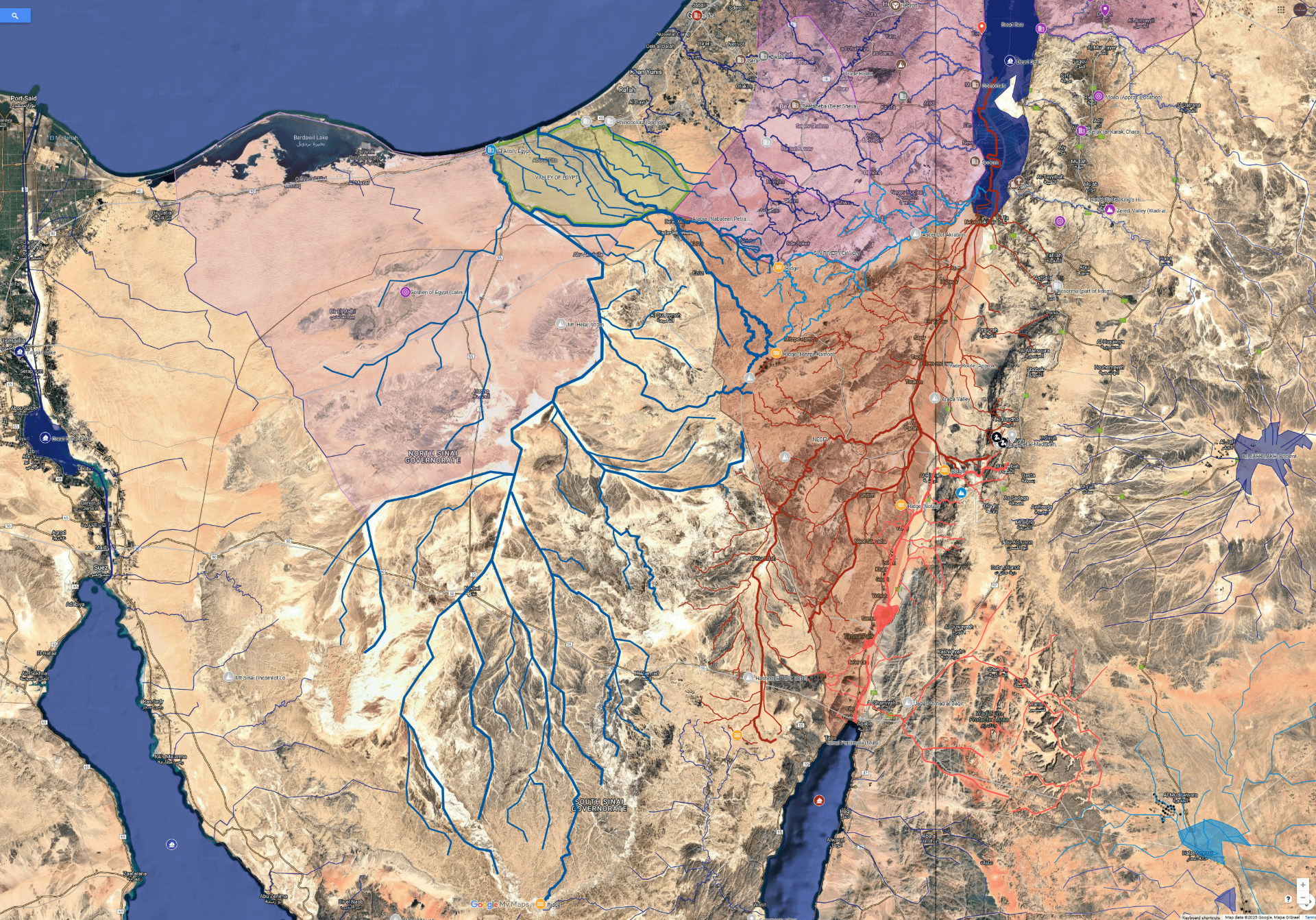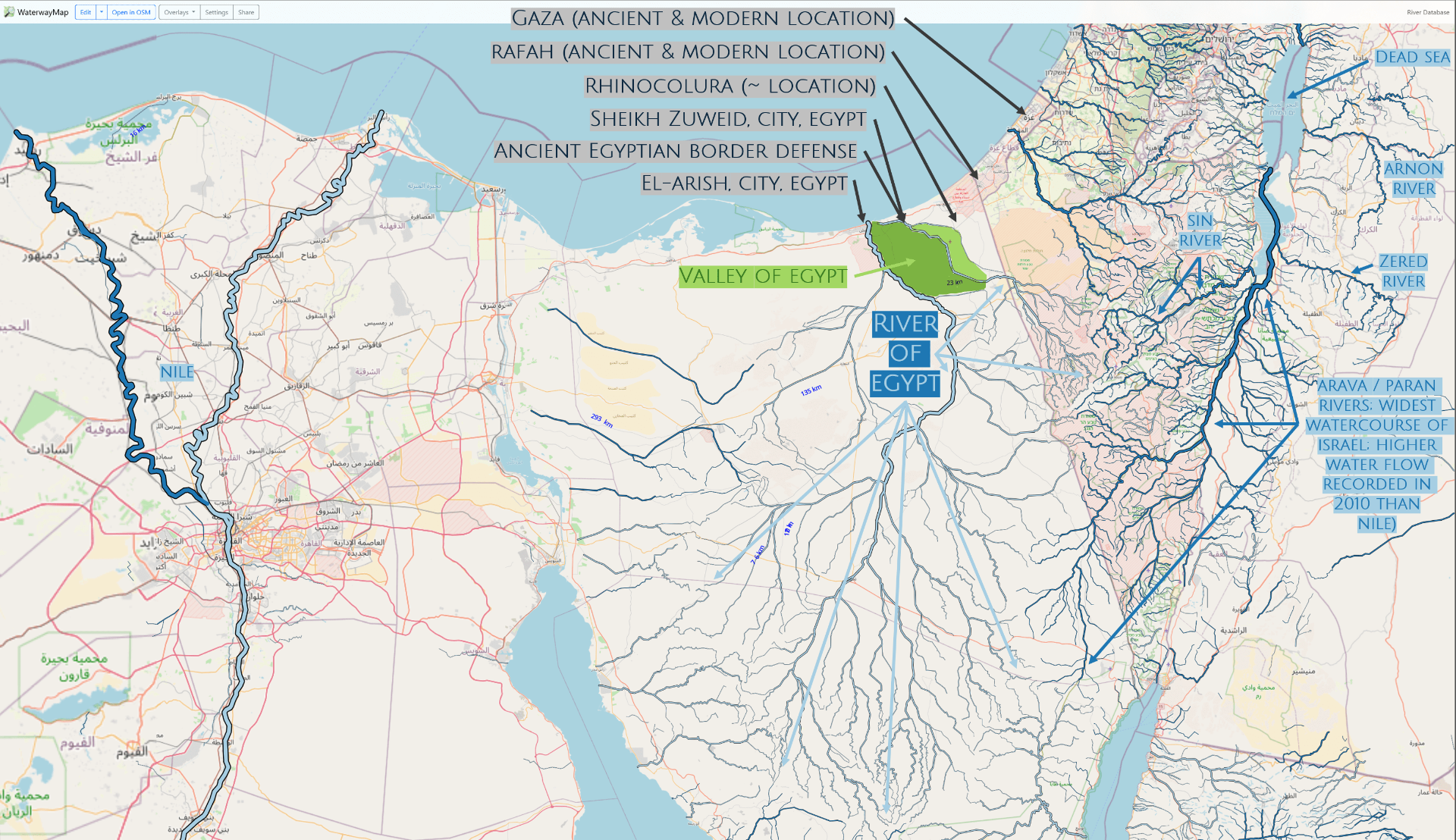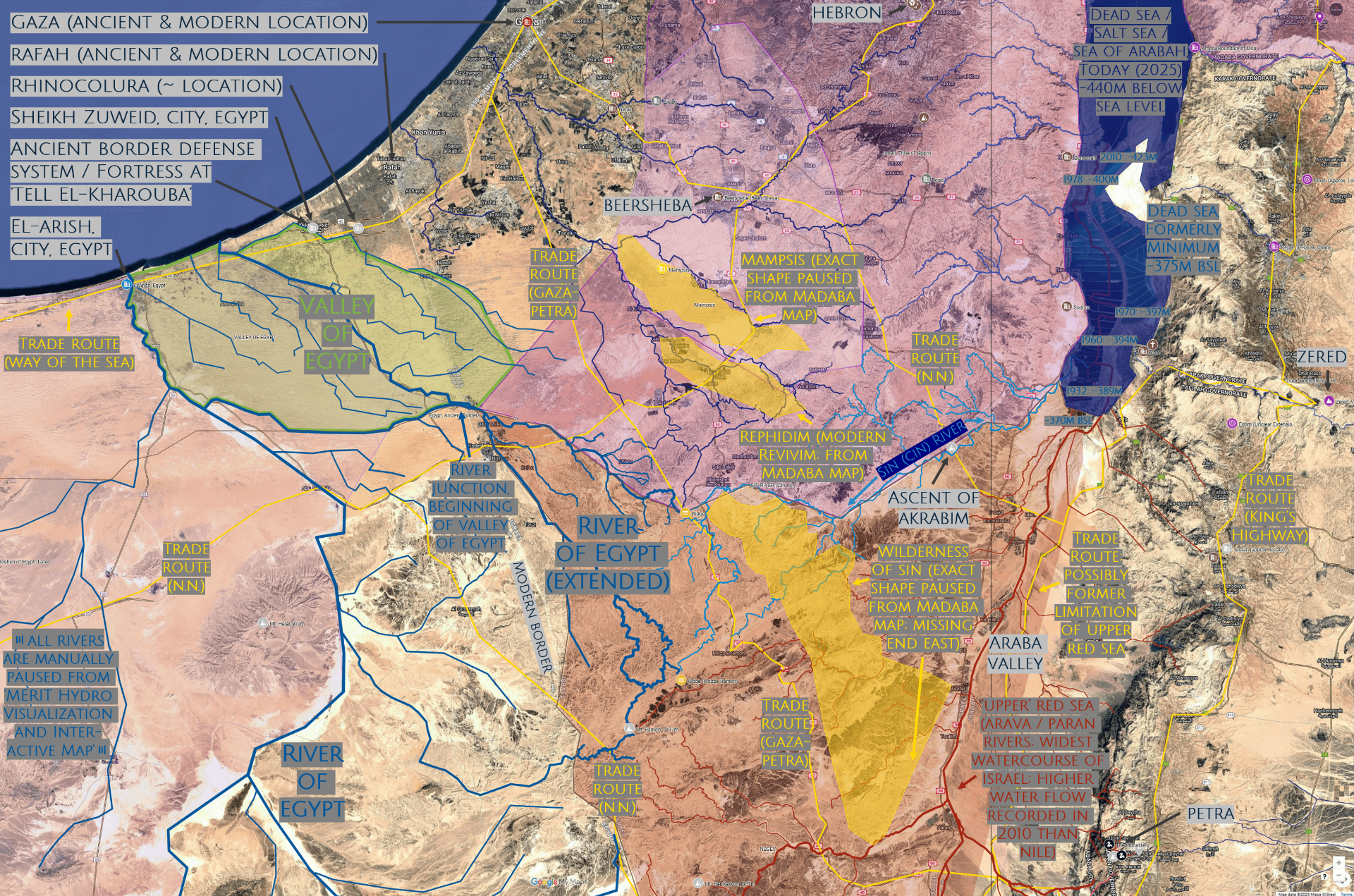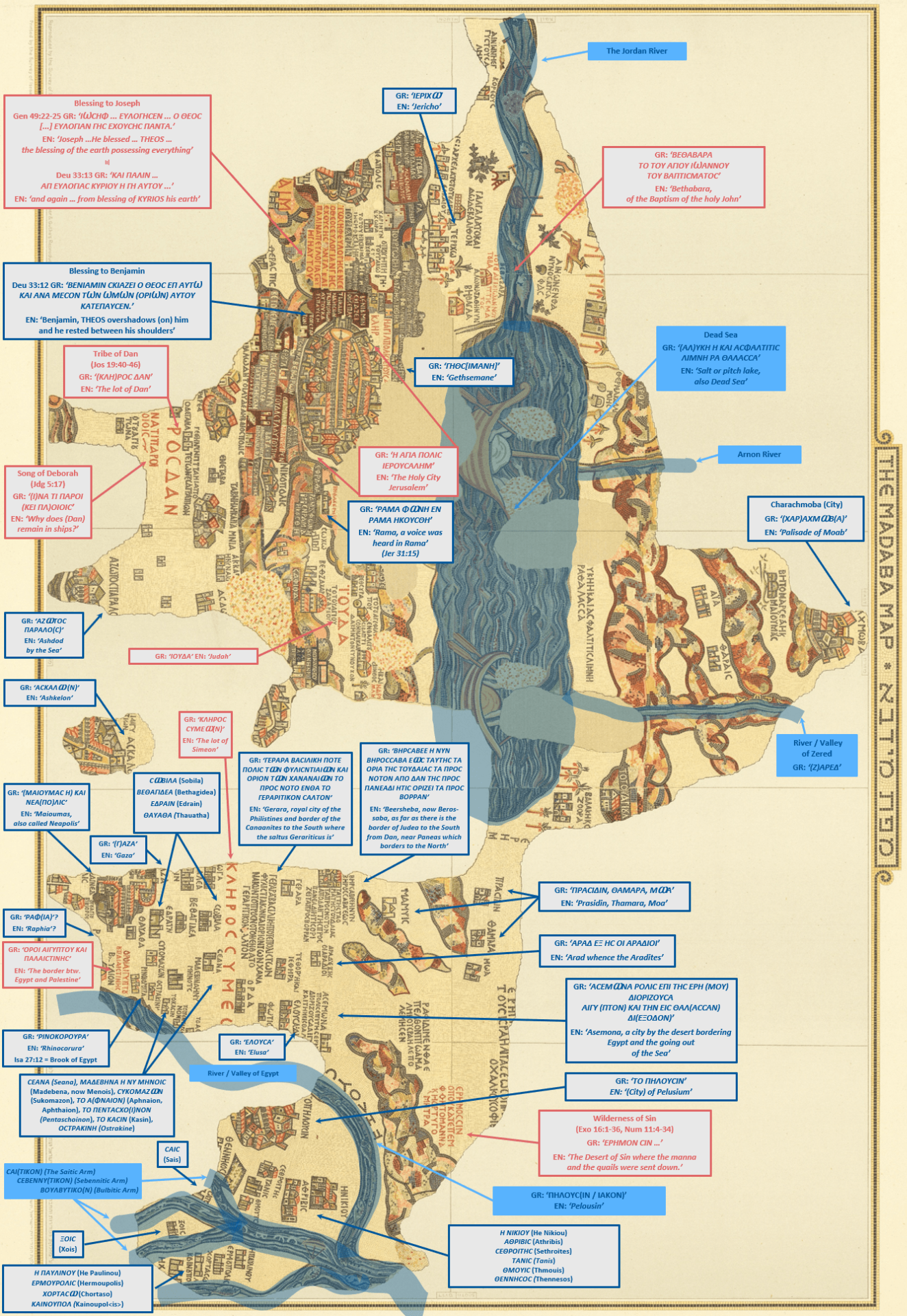Exodus from Egypt
.


Where was the River and Valley of Egypt?
Many Bible translations and interpreters make the dubious interpretation that the 'River of Egypt' is the Nile. But the true River of Egypt is found on the Sinai Peninsula, between the river 'Wadi el-Arish' which ends at the city 'El-Arish', and the city 'Sheikh Zuweid' (which is located 20km southeast of the city Rafah and ~50km southeast of the city of Gaza. This formerly very large and rather seasonal river system constitutes the biblical 'Valley of Egypt' and is the very definition of the southern border of the Promised Land.

- #1 The Valley of Egypt is described as the southern border of the Promised Land and must be located west of the Wilderness of Sin (see the Madaba Map below with its precise location).
Jos 15:2-4 "And their borders were from the south as far as a part of the salt sea from the high country that extends southward. 3 And they proceed before the ascent of Acrabin, and go out round Sena, and go up from the south to Cades Barne; and go out to Asoron, and proceed up to Sarada, and go out by the way that is west of Cades. 4 And they go out to Selmona, and issue at the Valley of Egypt; and the termination of its boundaries shall be at the sea: these are their boundaries southward."

- #2 The River of Egypt is also described as the southern border of the Promised Land.
Gen 15:18 "On that day KYRIOS made a covenant with Abram saying, "To your offspring I will give this land, from the River of Egypt to the great river, the Euphrates river ..."
Num 34:3-5 [Description of the Southern border of the Promised Land:] "And your southern side shall be from the wilderness of Sin to the border of Edom, and your border southward shall extend on the side of the salt sea eastward. 4 And your border shall go round you from the south to the ascent of Acrabin, and shall proceed by Ennac, and the going forth of it shall be southward to Cades Barne, and it shall go forth to the village of Arad, and shall proceed by Asemona. 5 And the border shall compass from Asemona to the River of Egypt, and the sea shall be the termination."
2Kin 24:7 "And the king of Egypt came no more out of his land: for the king of Babylon took away all that belonged to the king of Egypt from the River of Egypt as far as the river Euphrates."

- #3 The city Rhinocorura, which is localized on the Madaba Map near Gaza, is more importantly defined in the Bible as a border city along the River of Egypt.
Isa 27:12 "And it will be in that day KYRIOS will shut up together from the aqueduct of the river [Euphrates] unto Rhinocora.
'Rhinocorura' is exchanged for the 'River of Egypt' in the Masoretic text of that same verse: "And it has come to pass in that day, YHWH beats out from the branch of the river, to the stream of Egypt, and you are gathered one by one, O sons of Israel."

- #4 The Land of the Philistines is also equated with the southern border of the Promised Land.
1Kin 2:46 "And He reigned over all the kings from the river [Euphrates] and to the land of the Philistines, and to the borders of Egypt: so Solomon the son of David reigned over Israel and Judah in Jerusalem."

- #5 The Sinai Peninsula has been under the control of Egypt from before the Exodus in 1446 BC down until the Romans annexed the Sinai in 106 AD. Israel gained its control with the Six-Day War (1967 AD), but returned it already in 1978 AD to Egypt.
3100BC: part of Egypt, specifically of the First Dynasty of ancient Egypt. [1]
1446 BC (time of Exodus): area most probably in the hands of Egypt.
(853 BC: the word 'Arab' first appears in an official document. Moses would not even have known this term and / or tribe.) [1]
521–486 BC: part of the Persian province of Abar-Nahra ( Darius the Great). [1]
Egypt
305–283 BC: part of Ptolemaic Kingdom.
3rd c. BC - 106 AD: area in the hands of Arabia, possibly even the very portion in the North. [1]
106 AD - 630 AD: area in the hands of Arabia, without the portion in the North. [1]
Egypt
1260 - 1517 AD: under the Mamluk Sultanate of Egypt.
1517–1867 AD: part of Ottoman Empire.
Egypt
1882–1956 AD: part of the United Kingdom of Great Britain.
Egypt
1967 - 1989 AD: part of Israel.
1989 - today: Egypt.

- #6 The Bible makes it also very clear that Egypt (specifically Goshen and the nearby area where Pharaoh lived) was 'sandwiched' between the Mediterranean Sea (North) and the Red Sea (South), which is rather the Gulf of Aqaba and can hardly be the Gulf of Suez (which stretches north-south and can thus impossibly be a reference for a south wind).
Exo 10:12-19 "And KYRIOS said to Moses, stretch out thine hand over the land of Egypt, and let the locust come up on the land [...] and KYRIOS brought a south wind upon the earth, all that day and all that night: the morning dawned, and the south wind brought up the locusts [from the Red Sea; see verse 19 below], 14 and brought them up over all the land of Egypt. And they rested in very great abundance over all the borders of Egypt. [...] 19 And KYRIOS brought in the opposite direction a strong wind from the [logically Mediterranean] sea, and took up the locusts and cast them into the Red Sea, and there was not one locust left in all the land of Egypt."

- #7 The location of the River of Egypt and specifically the border of Egypt having reached until the town of Sheikh Zuweid, is also affirmed by the defense systems and military fortresses presented in 2025 to the public. The excavations site is called 'Tell El-Kharouba' and is located near at the border to Gaza, near the town Sheikh Zuweid.

- See also Openbible.info, Britannica.com and the article 'Brook of Egypt' on Wikipedia, which all point to the nearby 'Wadi al Arish' being the 'River of Egypt'. Yet many of our most popular Bible translations are still plastered with the grievous error and just plain manipulation of the Bible, including the Amplified Bible (AMP), Berean Standard Bible (BSB), English Standard Version (ESV), Christian Standard Bible (CSB), Good News Translation (GNT), International Standard Version (ISV), NET Bible (NET), New American Standard Bible (NASB), New International Version (NIV), New Living Translation (NLT), and many more Bible commentaries, which all substitute the 'River (of Egypt)' for the 'Nile', e.g. in passages such as Gen 41:1 (click for comparisons) or Exo 4:9 . . . The ESV is the inglorious leader, which even translates the 'Border of Egypt' in 1Chr 13:5 with the 'Nile of Egypt': "So David assembled all Israel, from the borders of Egypt [ESV only: 'Nile of Egypt'] even to the entering in of Hemath, to bring in the ark of THEOS from the city of Jarim." It should be apparent at this point that David would have never assembled all Israel up to the Nile, where his influence did unquestionably not reach. At least, all those manipulations do not include the 'River of Egypt' passages found e.g. in Num 34:5, Jos 15:4, 47, 1Kin 8:65, 2Kin 24:7, Isa 27:12.

Where was Goshen?
This area was given to Jacob and his family when they moved to Egypt (Gen 47:5-6). It became the Hebrew's homeland for up to 430 years and remained separate from the main Egyptian centers.
- #1 Egypt is not watered anymore since Old Testament times (excluding the entire Nile Area)
Gen 13:10 "And Lot having lifted up his eyes, observed all the country round about Jordan, that it was all watered, before THEOS overthrew Sodom and Gomorrha [estimated around 1900 BC], as the garden of KYRIOS [around 5500 BC], and as the land of Egypt [time of Lot which is concurrent with the destruction of Sodom; meaning that at least until ~400 years before the Exodus the land was still all watered], until you come to Zogora.
- #2 Goshen was at the fringe of Egypt and not 200 kilometers west of it!
Gen 46:34 "You shall say, we your servants are herdsmen from our youth until now, both we and our fathers: that ye may dwell in the land of Goshen of Arabia, for every shepherd is an abomination to the Egyptians."
- #3 Goshen was close to Gaza, not 250+ kilometers apart as the traditional location.
Exo 13:17 "And when Pharaoh sent forth the people, THEOS led them not by the way of the land of the Phylistines, because it was near; for THEOS said, Lest at any time the people repent when they see war, and return to Egypt. 18 And THEOS led the people round by the Way of the Wilderness, to the Red Sea."
Jos 10:41 "And Joshua struck them from Kadesh-Barnea as far as Gaza, and all the country of Goshen, as far as Gibeon."
> There are divided opinions on this last reference. While some scholars assign it to the same Goshen, others claim it to be a duplicate and transfer it northwards close to Jerusalem (see coordinates 31.847451, 35.183351; tribe of Judah because of the mention in Jos 15:51).
But we all agree that Judah extended to the very southern border of the promised land and the duplicate-option is solely based on the misinterpretation of the Brook of Egypt as Nile and the respective erroneous localization of the land of Goshen. If Goshen was adjacent to the future Canaan, then we have an entirely different scenario where there is no need to create a duplicate-option.
- #4 Goshen was an area very close or probably adjacent to the River of Egypt, having formed the border with the Philistines.
Gen 15:18 "On that day KYRIOS made a covenant with Abram saying, "To your offspring I will give this land, from the River of Egypt [clearly not the Nile, but the eastern border of Egypt] to the great river, the Euphrates river ..."
- #5 Goshen was not just any land, it was actually the best land of Egypt. The 'best' land in those times was clearly a land well watered and pastured, which the area surrounding the River of Egypt certainly was.
Gen 47:6-11 "Behold, the land of Egypt is before thee; settle your father and your brethren in the best land. 7 And Joseph brought in Jacob his father, and set him before Pharao; and Jacob blessed Pharao. 8 And Pharao said to Jacob, How many are the years of the days of thy life? 9 And Jacob said to Pharao, The days of the years of my life, wherein I sojourn, are a hundred and thirty years; few and evil have been the days of the years of my life, they have not attained to the days of the life of my fathers, in which days they sojourned. 10 And Jacob blessed Pharao, and departed from him. 11 And Joseph settled his father and his brethren, and gave them a possession in the land of Egypt, in the best land, in the land of Ramesses, as Pharao commanded. 12 And Joseph gave provision to his father, and his brethren, and to all the house of his father, corn for each person."
- #6 Goshen was not in Africa as commonly assumed, but most certainly on the Sinai Peninsula.
Gen 45:10 "And thou shalt dwell in the land of Goshen of Arabia ..."
While the Sinai Peninsula was mostly in Egyptian possession (since the First Dynasty in 3100 BC and most probably in the time of the Exodus; see timeline in above), it was later temporarily part of Arabia, which even caused the inclusion of the term 'Goshen of Arabia' in the Greek Old Testament (written approx. 250 BC). It reflected through this designation very early, what the Romans would only adapt in 106 AD, when they officially named the Sinai Peninsula 'Aarabia'.
Moses did most probably not yet know the term 'Arabia' in his time and would have called it 'Goshen of Egypt'. Arabia covered later the southern part, and for some time even the entire Sinai Peninsula including Goshen in the north. [1]
- #7 There is a reason why archeologists have never found a significant and directly assigned substance in the traditionally researched region.


Where was the Biblical Red Sea?
The Red Sea was the very deep river or rather ocean which the Israelites miraculously crossed and where Pharaoh and his army died therein.


- #1 Opposite of the Sea and Land of the Philistines
- #2 The Red Sea is the border of Canaan
Many scholars claim the Gulf of Suez to be the biblical Red Sea, but such a claim is opposed by the Bible itself, which makes it perfectly clear that the Red Sea is on the side opposite to the coast of the Philistines.
Exo 23:31 "And I will set thy borders from the Red Sea, to the Sea of the Phylistines [Mediterranean Sea], and from the wilderness to the great river Euphrates; and I will give into your hand those that dwell in the land, and will cast them out from thee."
It is a mystery why this Bible verse alone does not cease all discussions of a supposed equivalence with the Gulf of Suez, which would extend the Holy Land over the entire Sinai Peninsula.

- #3 The literal Red colour of the Sea
This colour excludes a salt water ocean and clearly implies its origin in a river which is being fed by mountains absorbing this particular colour. The satellite view above reveals this to be the case (already to the unschooled eye), especially when looking at the mountains to the east. Wadi Rum is e.g. famous for red stones and sand, which contain metals (iron oxide), which are being washed into the local river system. [1] [2]

- #4 The Red Sea was not a pointer far south on the horizon, but actually implied a parallel route the people travelled.
Num 14:25 "But Amalec and the Chananite dwell in the valley: tomorrow turn and depart for the wilderness by the Way of the Red Sea."

- #5 The Land of Edom does impossibly reach until the Gulf of Suez.
1Kin 9:26 "... even that for which king Solomon built a ship in Gasion Gaber near Ælath on the shore of the extremity of the Sea in the land of Edom."

- #6 The biblical Red Sea is mainly fed through 7 ravines / rivers / streams.
Isa 11:15 "And KYRIOS shall make desolate the Sea of Egypt [which is widely agreed upon that it speaks of the Red Sea; G2281 thalassan = sea, lake]; and He shall lay His hand on the river [G4215 potamon = brook, flood, river, stream, water] with a strong wind, and He shall smite the seven ravines [G5327 pharangas = channel, chasm, gap, ravine, valleys; this makes it clear that the Red Sea is fed by 7 rivers or streams; neither the Gulf of Suez nor the Gulf of Aqaba could fulfill this criteria], so that men shall pass through it dry-shod. And there shall be a passage for my people that is left in Egypt: and it shall be to Israel as the day when he came forth out of the land of Egypt."
Where was Midian?
The only logical location of the biblical Midian can be east of the Jordan River, half-way between the Dead Sea and the Sea of Galilee. It was definitely not located 400 kilometers further south as the proponents of the Mt. Sinai location at Jebel al Lawz believe.
~450 years before the Exodus (in ~1898 BC, when Joseph was sold to Ismaelites / Midianites), their caravan came from the north (Gilead). ~300 years after the Exodus (~1154 BC, when Gideon and his 300 warriors pursued the Midianites far into their territory), they went as far as Jogbehah also located north, probably close to modern Amman.
- #1 It must logically be located outside of Egypt.
Exo 2:15 "And Pharaoh heard this matter, and sought to slay Moses; and Moses departed from the presence of Pharaoh, and dwelt in the land of Midian; and having come into the land of Midian, he sat on the well."
- #2 East of Canaan and of the Jordan River.
Gen 25:4-6 "And the sons of Midian were Gephar and Aphir, and Enoch, and Abeida, and Eldaga; all these were sons of Chettura [...] to the sons of his concubines Abraam gave gifts, and he sent them away from his son Isaac, while he was yet living, to the east into the country of the east."
- #3 Closer to the latitude of Jezreel Valley; on the other side of the Jordan River.
Jdg 6:33 "And all Madiam, and Amalek, and the sons of the east gathered themselves together, and encamped in the Valley of Jezrael."
- #4 Midianites were identical or part of the Ismaelites; they lived close to, or in Gilead.
Gen 37:25-36 "25 ... Ismaelitish travellers came from Galaad, and their camels were heavily loaded with spices, and resin, and myrrh; and they went to bring them to Egypt. [...] 27 Come, let us sell him to these Ismaelites [...] 28 And the men, the merchants of Madian, went by, and they drew and lifted Joseph out of the pit, and sold Joseph to the Ismaelites for twenty pieces of gold; and they brought Joseph down into Egypt. [...] 36 And the Madianites sold Joseph into Egypt; to Petephres, the eunuch of Pharao, captain of the guard."
Gen 39:1 "And Joseph was brought down to Egypt; and Petephres the eunuch of Pharao, the captain of the guard, an Egyptian, bought him of the hands of the Ismaelites, who brought him down thither."
This caravan route was part of the ΟΔΟΝ ΘΑΛΑϹϹΗϹ (Isa 8:23 Greek / Isa 9:1 Masoretic; Odon Thalasses, Way of the Sea), also called in Latin Via Maris. [1]
- #5 Route Egypt - Paran - Midian
1Kin 11:18 "They set out from Midian and came to Paran and took men with them from Paran and came to Egypt."
- #6 Gideon pursued the Midianites for approx. 100 kilometers to Succoth and close to Amman.
Jdg 8:4 "And Gedeon came to Jordan, and went over, himself and the three hundred with him, hungry, yet pursuing. 5 And he said to the men of Socchoth ..."
Jdg 8:11 "And Gedeon went up by the way of them that dwelt in tents, eastward of Nabai and Jegebal; and he smote the host, and the host was secure. 12 And Zebee and Salmana fled; and he pursued after them, and took the two kings of Madiam, Zebee and Salmana ..."
- #7 Neighbors, overlapping or very close to Moab (which is also east of Canaan).
Num 22:1-7 "And the children of Israel departed, and encamped on the west of Moab by Jordan toward Jericho. 2 And when Balac son of Sepphor saw all that Israel did to the Amorite, 3 then Moab feared the people exceedingly because they were many; and Moab was grieved before the face of the children of Israel. 4 And Moab said to the elders of Madiam, Now shall this assembly lick up all that are round about us, as a calf would lick up the green herbs of the field: - and Balac son of Sepphor was king of Moab at that time. 5 And he sent ambassadors to Balaam the son of Beor, to Phathura, which is on a river of the land of the sons of his people, to call him, saying, Behold, a people is come out of Egypt, and behold it has covered the face of the earth, and it has encamped close to me. 6 And now come, curse me this people, for it is stronger than we; if we may be able to smite some of them, and I will cast them out of the land: for I know that whomsoever thou dost bless, they are blessed, and whomsoever thou dost curse, they are cursed. 7 And the elders of Moab went, and the elders of Madiam, and their divining instruments were in their hands; and they came to Balaam, and spoke to him the words of Balac."
- #8 Not too far from Moses' place of death north of Moab.
Num 31:1-2 "Avenge the wrongs of the children of Israel on the Midianites, and afterwards thou shalt be added to thy people."
- #9 Midian died in the plains of Moab (East of Jericho).
Gen 36:35 "... Adad ... who cut off Madiam in the plain of Moab ..."







